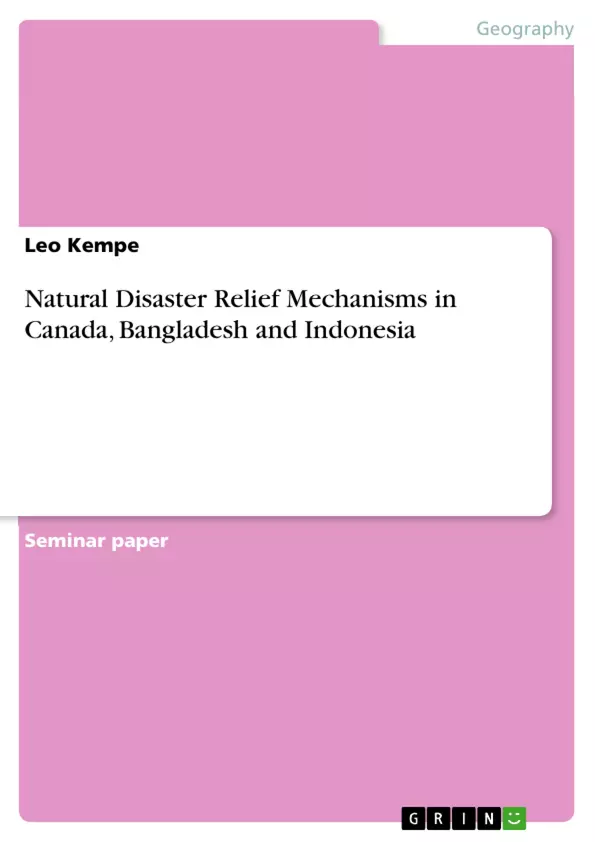This paper looks at policy input in three countries to manage natural disasters that occur on a regular basis.
These countries are Canada, Bangladesh, and Indonesia. In the chapters about Canada, information about wildfires and (flash) floods is presented, looking at various reasons for the disasters as well as institutions involved in policymaking. The same content goes for cyclones in Bangladesh and earthquakes in Indonesia.
In all four instances, historical evidence about particularly strong cases of these four types of disasters is presented, which underscores the continuous relevance for society and politics. Including a variety of information of different types of sources, the paper contributes to a debate about disaster management and relief mechanisms as well as policymaking capacities.
Inhaltsverzeichnis (Table of Contents)
- Introduction
- Country: Canada – North American Climate Change Vulnerabilities
- Defeating Heat and Devastation: The FireSmart Program
- Flood Risk and Preparation in Canada
- Country: Bangladesh – Mitigating Cyclone Risks
- A History of Disaster: Cyclones in Bangladesh
- Policy Frameworks and Response Mechanisms
- Country: Indonesia – Mitigating Earthquake Risks
- The Ring of Fire: Earthquakes in Indonesia
- Mitigation and Response Mechanisms
Zielsetzung und Themenschwerpunkte (Objectives and Key Themes)
This research paper examines disaster relief mechanisms in Canada, Bangladesh, and Indonesia, focusing on the impacts of wildfires, floods, cyclones, and earthquakes. The paper aims to analyze policy mechanisms and cooperation efforts implemented or planned by each country to address these natural hazards. By highlighting the motivations and approaches behind disaster relief efforts, the paper emphasizes the importance of resilient and responsive institutions in fostering adequate coping strategies. The paper also explores the synergistic effects of transnational cooperation and examines the similarities and differences between the selected countries to identify applicable learnings across broader political and geographical contexts.
- Disaster relief mechanisms in Canada, Bangladesh, and Indonesia
- Policy mechanisms and cooperation efforts for natural disaster response
- The role of resilient and responsive institutions in disaster preparedness and recovery
- Transnational cooperation in disaster relief
- Comparative analysis of disaster response strategies across different contexts
Zusammenfassung der Kapitel (Chapter Summaries)
The paper begins by introducing the overarching theme of climate change and its impact on disaster risks. It then delves into the specific case of Canada, analyzing wildfire and flood threats. Chapter 2.1 focuses on the FireSmart program, a community-based initiative designed to reduce home vulnerability and increase wildfire preparedness. The chapter further discusses flood risks in Canada, highlighting the role of climate change in exacerbating these hazards.
The paper continues by examining disaster relief mechanisms in Bangladesh, specifically addressing the risks posed by cyclones. This chapter explores the historical context of cyclones in Bangladesh and the policy frameworks in place for disaster preparedness and response. The chapter also highlights the importance of community engagement and international cooperation in mitigating cyclone risks.
Finally, the paper concludes by exploring earthquake risks in Indonesia, emphasizing the country's location in the "Ring of Fire." It analyzes the mitigation and response mechanisms implemented by Indonesia to address earthquakes, highlighting the importance of early warning systems, building codes, and community resilience.
Schlüsselwörter (Keywords)
This research paper focuses on disaster relief mechanisms, climate change impacts, policy analysis, transnational cooperation, institutional resilience, and the Sustainable Development Goals (UN SDGs). It explores specific case studies of wildfire, flood, cyclone, and earthquake risks in Canada, Bangladesh, and Indonesia. The paper highlights the importance of a multi-faceted approach to disaster preparedness and recovery, emphasizing the role of effective institutions, community engagement, and international collaboration.
- Quote paper
- Leo Kempe (Author), 2022, Natural Disaster Relief Mechanisms in Canada, Bangladesh and Indonesia, Munich, GRIN Verlag, https://www.hausarbeiten.de/document/1441565


